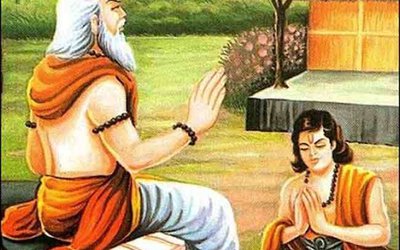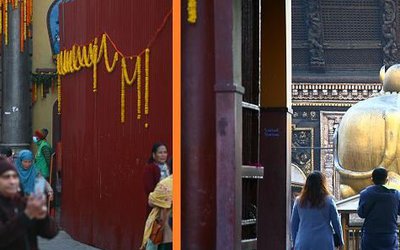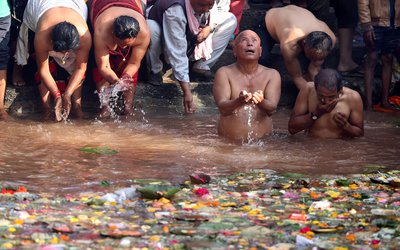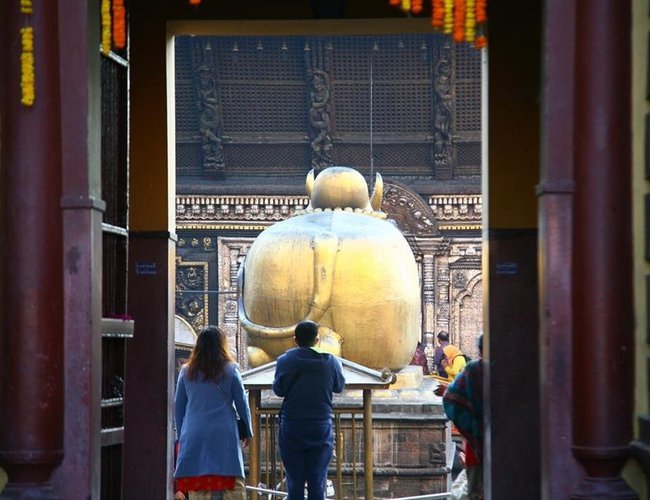
Shivaratri Festival at Pashupatinath Temple
Located on the bank of the holy Bagmati river to the eastern part of Kathmandu, Pashupatinath Temple is revered as the holiest shrine of Lord Shiva. The two-tiered pagoda-style temple at the center of the town of Deopatan was originally built by Supuspadeva, a Lichchhavi king in 753AD. The temple was attacked and badly destroyed by Sultan Samsuddin of Bengal in the mid14th century.
The temple was then erected new in the 17th century by King Bhupatindra Malla. There are gold gilt doors on all the four faces of the temple inside which stands the about three feet high Shivalinga with four faces. All these faces of the black stone diety have different names and significances and are worshipped at different times of the day. The Namboothiri Brahmins from Kerala, India are the priest to do all the rites and rituals in the temple and only 4 priests can touch the deity.
Hundreds of thousands of Hindu devotees throng at Pashupatinath on the holy occasion of Maha Shivaratri. People gather at the temple from as early as 2 AM in the morning to worship the deity. Recently the authorities have inducted a system of a priority line for NRs.1000 who would not have to stand on a line for the holy darshan of the Shrine. Pashupatinath becomes a major attraction for tourists from all over the world on this day especially because of the Sadhus and Naga Babas (the naked Hindu monks). It is the Sadhus who travel long distances on foot mostly from India to reach Pashupatinath, making it an extra bit special during the Shivaratri. Most of them have their bodies painted with turmeric vermilion or holy ash, a Rudraksha garland on the neck and decorated body parts with bright colors. They usually attract a huge crowd as most of them are high on Hashish and Marijuana, which are offered to them for free by the Governmental authorities. There are a lot of Naked Sadhus, better known as Nagas, who walk around completely naked. They become the center of attraction for a lot of tourists. These spiritual warriors are taken special care and provided with proper food and even travel fare by the Government authority. Bonfires are lit and feasts of food are put out for all in the Pashupatinath area for the devotees. As the area is crowded with almost a million visitors on the day so Nepal Police, Red Cross, Medical and Emergency services and public volunteers assist in the queue management, sanitation, safety and security issues.
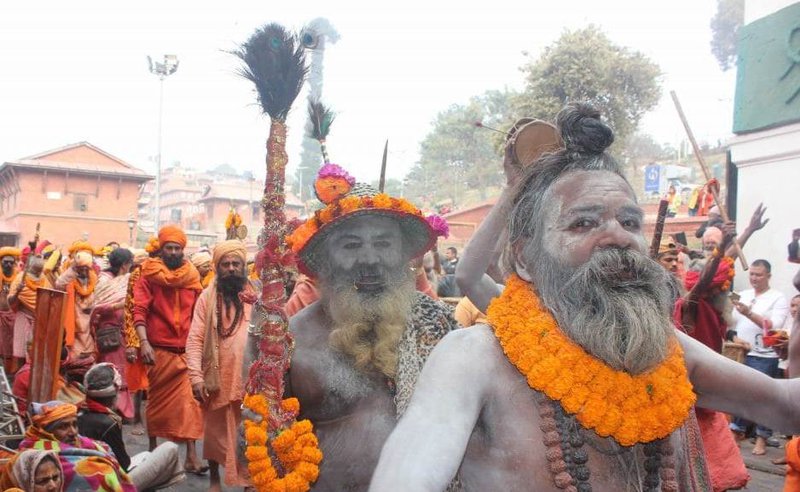
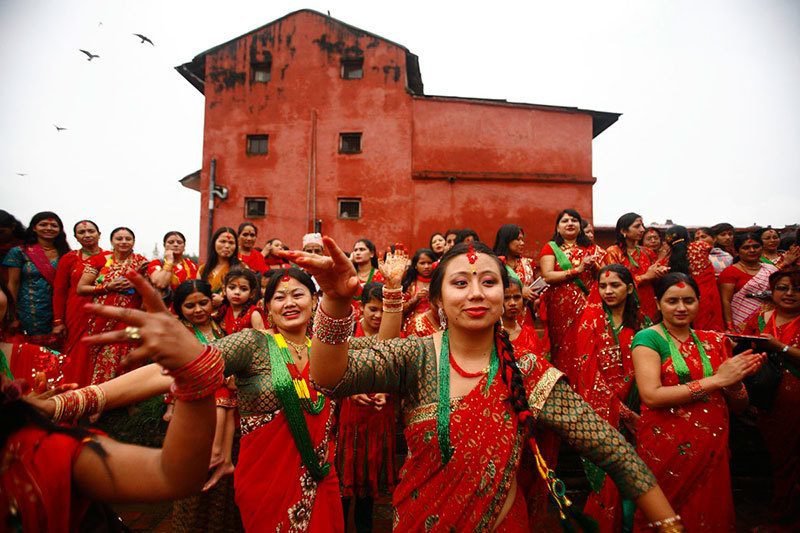
Maha Shivaratri Meaning
Maha Shivaratri (meaning the great night of Shiva- the holiest deity of Hindus) falls on the moonless (Falgun Krishna Paksha) 14th night of the new moon in the Hindu month of Falgun, which corresponds to the month of February - March in the English Calendar. Hindu devotees celebrate this day as one auspicious occasion and observe a strict fast in honor of Lord Shiva-the supreme power of primal creation, preservation and destruction. Hindus believe that devoted fasting would please Lord Shiva and absolve a person of all the sins to liberate him for the cycle of birth and death. Married women observe fast and worship Lord Shiva and Parvati (spouse of Lord Shiva) to shower their grace for a peaceful and blissful married life while the unmarried girls pray for an ideal husband like Shiva.
Why is Shivaratri Celebrated?
As per Hindu mythology, there are many legends marking this day as Shivaratri. It is believed that Shivaratri is the auspicious day when day Lord Shiva and Parvati got married. Some believe that on this very night, Lord Shiva saved the world by drinking the poison that emerged from the ocean during the great mythical churning of the ocean and threatened to destroy the entire world. Lord Shiva drank the poison which turned his throat blue, giving him the name Nilkantha. Later to quench the heat from the poison he pierced Earth using his Trishul and drank the holy water at the Himalayas, the place today is revered as Gosainkunda.
Another popular legend from Hindu mythology says that this is the auspicious night when Lord Shiva manifested himself in the form of a Linga, a symbol for the worship of Lord Shiva. Also, some believe that this is the night when Lord Shiva performed Tandava- the divine dance performed by Lord Shiva that is the source of the cycle of creation, preservation and dissolution.
What do people do in Shivaratri?
Millions of Hindu Devotees worship Lord Shiva on this day at all the different famous Shiva Shakti Peetham. Nishita Kal is the ideal time to observe Shiva Pooja as per the Hindu traditions. Devotees clean the Shiva Lingas and offer cold water, milk and belpatra (aromatic leaves Bael- species of tree, native to Indian Subcontinent) on the holy Shiva Lingas. Sadhus-the Hindu monks visit holy shrines of Lord Shiva and offer marijuana to worshippers. They portray themselves as the ardent follower of Lord Shiva by wearing a garland made of Rudraksha and applying turmeric vermilion or holy ash on the forehead as did Lord Shiva. They recite holy mantras and perform special pujas throughout the night to celebrate Shivaratri. Most people often keep an all-night-long vigil (jagarana). All through the day the devotees, chant the sacred Panchakshara mantra dedicated to Lord "Om Namah Shivaya". All the sweet shops sell Ladu or any form of cake or Special Lassi (milkshake) on this very day with Bhang (made out of leaves and flowers (buds) of the female cannabis plant) as a gracious offering to Lord Shiva.
Maha Shivratri is the most auspicious day dedicated to Lord Shiva and is popularly known as the night of Siva. Shivratri 2022 date is March 1, Tuesday as per panchangs in Nepal and India.
This holy night of Shiva is observed on the night before ‘amavasya’ in the Hindu month of Phalgun (February – March) as per traditional Hindu calendar followed in North India. The corresponding period in other regions is the night before Magh Amavasya.
The best time to perform puja is from 12:23 AM on March 2 to 12:59 AM on March 2 early hours midnight. Nishita Kala is chosen to perform pujas and rituals on Shivratri. All pujas and rituals are completed before Amavasya (No moon) starts.
Nishita Kala Puja time is 12:23 AM on March 2 to 12:59 AM on March 2. Chaturdashi tithi in North, South and Eastern parts of India is from 3:16 AM on March 1 to 1:01 AM on March 2.
Chaturdashi tithi in Western parts of India is from 3:16 AM on March 1 to 1:01 AM on March 2.
It must be noted here that Shivratri is observed during Phalgun month in North India. The corresponding month in Gujarat, Maharashtra, Karnataka, Goa, Telangana and Andhra Pradesh is Magh Month.
Shivratri Importance
Most Hindu festivals are noted for its mirth and color but Shivratri is a night dedicated to prayers and contemplation. Of course, when Lord Shiva is worshipped there is joy all around but it is not just joy but bliss that is achieved through Brahman realization – When Lord Shiva is seen in all animate and inanimate.
When we realize that it is his Tandava that creates each cell and it is his Tandava that is responsible for the transformation of each cell – we attain Moksha.
The significance of Shivratri is closely associated with ‘amavas’ - the no moon night or full dark night as per traditional Hindu Calendar. Amavas symbolically represents Kaliyuga or spiritual ignorance. Lord Shiva appeared just before the beginning of Kaliyuga to rid the world of evil and ignorance. Therefore Shivratri is celebrated to get rid of evil and ignorance.
On the Shivratri day, Lord Shiva is worshipped in a special form of Linga called ‘Lingodbhavamurti.’ It is a lingam in the form of fire which has neither a beginning nor an end. It must be noted here that ‘linga’ means ‘sign.’ And it is merely an attempt to capture the formless or Brahman.
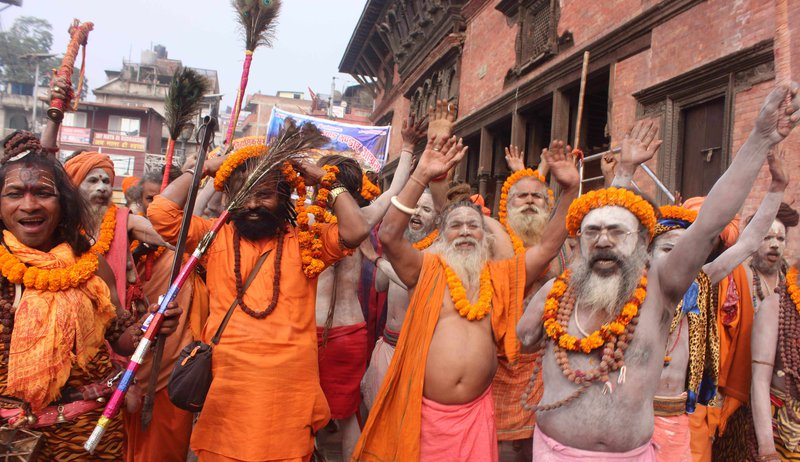
Shivratri Story and Origin
There are numerous legends and myths associated with Shivratri, which is mainly found the Puranas associated with Shiva.
An important myth is that Shivaratri is the birthday of Lord Shiva – this is because the formless Lord Shiva appeared for the first time in the form of Lingodbhavamurti or Jyotirlinga before Lord Vishnu and Brahma.
Myth of Shivratri based on Vishnu and Brahma searching for the origin of Linga
Lord Vishnu and Brahma wanted to know who was superior and this led to a fight. Lord Shiva intervened and said whoever can find out the origin or end of Shivling is superior. Lord Shiva appeared before them in the form of a huge pillar of fire. Lord Vishnu went down searching and Brahma went up searching. Both traveled and traveled but never met the beginning or end.
After the futile search, Lord Vishnu and Brahma prayed to Shiva and appeared before them in the form of Jyotirlinga and this day of the appearance of Lord Shiva is celebrated as Shivratri.
The Story of Shivratri based on Samudra Manthan
This is a famous legend on Shivaratri and happened during the churning of the ocean by Devas and Asuras to get ‘Amrit.’ While churning the ocean, highly toxic poison came out and Lord Vishnu asked the ‘devas’ and ‘asuras’ to approach Lord Shiva. He agreed immediately to help them and drank the poison. In order for the poison to have no effect, Lord Shiva should not sleep. So the ‘devas’ and ‘asuras’ kept praying the whole night. Pleased with the devotion Lord Shiva said ‘whoever worships me on this day will get their wishes fulfilled.’
Maha Shivratri and the fall of ketaki flower
This myth is similar to the appearance of the Jyotirlinga legend. Brahma went up searching for the end of the Jyotirlinga and Vishnu went down. Brahma after traveling for a while saw a ketaki flower (screw pine) dangling down. He stopped his search and took the flower and returned to Lord Shiva. Vishnu too came back soon and expressed his inability to find the beginning. But Brahma said he found the ketaki flower atop the Jyotirlinga and ketki supported it. Lord Shiva became furious and cursed ketki flower that it will not be offered in worship.
The story of Shivratri is based on hunter unknowingly dropping Bilva leaves on Lingam
There once lived a tribal hunter who was a Shiva devotee. One day he lost his way while hunting and was trapped in the forest at night. Soon wild animals started to gather around him and he climbed a Bel or Bilva tree. In order to keep himself awake, he started plucking Bilva leaves and dropping it down repeating ‘Om Namah Shivaya.’ In the morning, he discovered that he had been dropping the leaves on a Shivling. And the word spread that he was saved by Lord Shiva. People started celebrating the day as Shivratri. The story is mentioned in Mahabharata by Bhishma while on the bed of arrows. The hunter was born as King Chitra bhanu who could remember his previous births. And he discussed the importance of Shivaratri with a sage.
Shivratri Puja and Fasting
Shivratri puja and fasting begin with the sunrise on Chaturdashi day.
It is a complete fast on the day and people keep vigil at night or spend time in Shiva Temples or at sacred spots associated with Lord Siva.
At home, one should keep chanting the mantra 'Om Namah Shivaya.' If you have a Shivling you can offer water to it.
Shiva is worshipped on the day with bilva leaves, datura, flowers, rice, water, milk, and panchamrut (milk, curd, ghee, sugar and honey). Lord Shiva is worshipped throughout the night.
The main puja is held at midnight.
The next day morning a sacrifice is performed with barley, sesame, porridge, bilva leaves and the fasting is completed. This is performed at temples and in sacred places.
At homes, people offer bilva leaves and water to Lord Shiva and end the vow with prayers.
Food That Can Be Eaten During Shivratri Fasting
Food Eaten on the Shivratri Day
Most devotees go for a fruit diet and drink lots of water.
Since it is long fasting many people consume a special meal known as ‘phalar.’
Some people consume a mid-day meal consisting of non-cereal food such as boiled potatoes which is made into a curry without onion, garlic, dark or Haldi.
Another food eaten on the day is pakora or Kuttu Singhare ki puri.
No meal is eaten after sunset.
The next meal is taken on the morning of Amavasya (the next day morning) after doing puja and giving alms.
Mantras to be Chanted on Shivratri
Some of the important mantras that are chanted on the day include:
Shiva Panchakshari Mantra (Om Namah Shivaya)
Chanting the sacred names of Lord Shiva
Mahamrityunjaya Mantra etc.
People also listen to Lingashtakam and Bilvashtakam.
Planetary Position on Shivratri Night
It is believed that the planetary positions align in such a way on Shivratri night that it naturally creates an upsurge of energy in the human system. This is also why traditionally it is known to be beneficial both physically and spiritually to stay awake and aware through the night.
Benefits of Observing Shivaratri
All the rituals on the night of Shivaratri are meant to cleanse the ignorance and realize that all animate and inanimate is nothing but the Supreme Truth Shiva.
The fasting, rituals and chanting are meant to kill desire, greed, illusion, arrogance, jealousy, and anger.
This will make you a better person and prepare you to face challenges.
Shivratri in All Months of a Hindu Year
Incidentally, there is a Shivratri in each month of the Hindu calendar. This is known as Masa Shivratri and is observed by staunch Shiva devotees. It is observed on the fourteenth day during the waning phase of the moon or Krishna Paksha Chaturdashi in all traditional Hindu months.
Another important Shivratri in the year is during Shravan month (July - August). This is part of the Masa (or monthly) Shivratri observed by staunch Shiva devotees.
PADT Completes Preparation To Hold Maha Shivaratri Festival
A necessary arrangement has been completed to welcome tens of thousands of devotees in the Maha Shivaratri, the Pashupati Area Development Trust (PADT) said on Sunday.
Devotees from different parts of the country and India and other countries will throng Pashupatinath Temple on the day of Maha Shivaratri.
Organizing a press meeting today, Maha Shivaratri Festival Management Main Organising Committee informed that the committee was ready to welcome thousands of devotees and 10 different sub-committees had completed all management tasks for Maha Shivaratri day.
Narayan Prasad Subedi, treasurer of PADT, said that 10,000 security personnel from Nepal Police, Armed Police personnel and National Investigation Department would be deployed to maintain a sound security system. Around 5,000 volunteers would also be deployed on the premises of the Pashupati Temple to manage the crowd and devotees’ lines.
Dr. Ghana Shyam Khadiwada, executive director of PADT, estimated that around Rs. 12.5 million will be collected from various sources on the Shivaratri festival day.
PADT had separated a budget of Rs. 11.5 million for making preparations for the festival this year.
The committee has made arrangements for devotees to offer worship to Lord Shiva, making four separate lines from different places. All four doors of the temple will open from 3:00 AM on Tuesday.
Volunteers, security forces and medical clinics and health camps have been set up inside the temple.
Around 95 organizations will distribute free meals, water and tea to the devotees, saints and Sadhus.
Armed Police Force, Nepal Police and around 60 health organizations will set up health camps with the facilities of doctors, nurses, beds and ambulances.
Likewise, traffic moving towards Gaushala and the temple area will be blocked. Vehicles will not be allowed to move towards Gaushala from Mitrapark, Maitidevi, Old Baneshwor, Battisputali, Rato Pul, Shifal and Anamnagar.
PADT has designated five places for shoe safekeeping. Likewise, Tilganga corridor area, PADT office, Traffic Police Office of Gaushala, Sifal ground, across the Guheshwori area are allotted for parking the vehicles.
The entrance gates of Pashupatinath Temple and its premises and other areas are specially decorated with electric lights and flowers.
- The Sentiment Of Monetary Policy Seems Focused On Increasing Eemand: FNCCI President Chandra Prasad Dhakal
- Jul 26, 2024
- Monetary Policy 081/82 Is Making The Economy More Dynamic: Governor Adhikari
- Jul 26, 2024
- Global IME Bank And Shashila Motors Signed Agreement Regarding Electric Vehicle loan
- Jul 26, 2024
- Lok Bahadur Thapa, permanent representative of the UN in New York, was appointed as the Vice President of ECOSOC
- Jul 26, 2024
- Leeladevi Gadtaula Became The First woman Chief Secretary
- Jul 26, 2024

